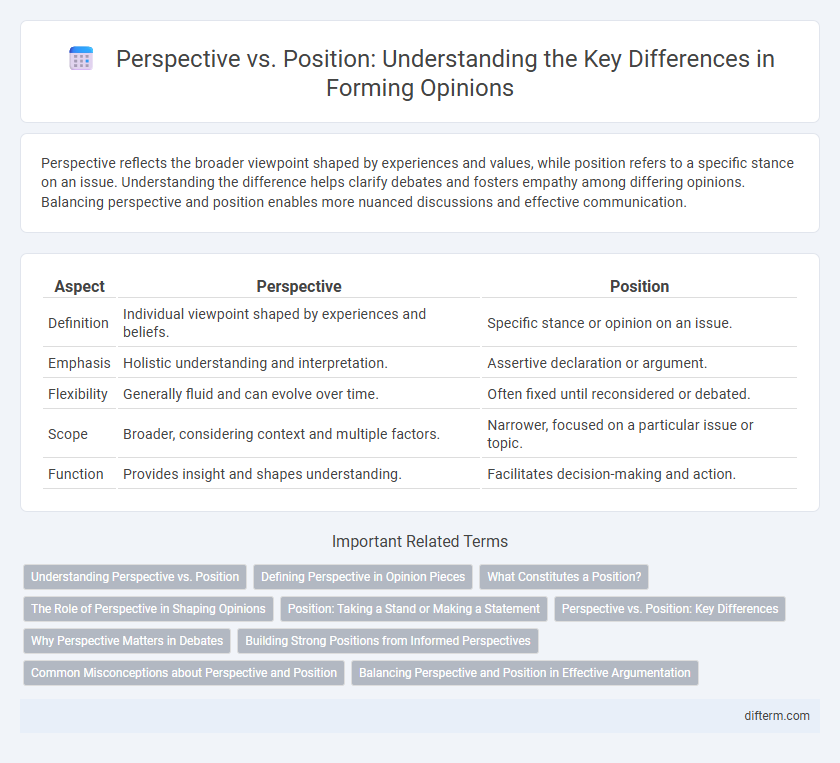Perspective reflects the broader viewpoint shaped by experiences and values, while position refers to a specific stance on an issue. Understanding the difference helps clarify debates and fosters empathy among differing opinions. Balancing perspective and position enables more nuanced discussions and effective communication.
Table of Comparison
| Aspect | Perspective | Position |
|---|---|---|
| Definition | Individual viewpoint shaped by experiences and beliefs. | Specific stance or opinion on an issue. |
| Emphasis | Holistic understanding and interpretation. | Assertive declaration or argument. |
| Flexibility | Generally fluid and can evolve over time. | Often fixed until reconsidered or debated. |
| Scope | Broader, considering context and multiple factors. | Narrower, focused on a particular issue or topic. |
| Function | Provides insight and shapes understanding. | Facilitates decision-making and action. |
Understanding Perspective vs. Position
Understanding perspective involves recognizing the underlying beliefs, emotions, and experiences that shape one's viewpoint, offering a deeper insight into why opinions are held. Position refers to a specific stance or judgment on an issue, often presented as a clear and fixed statement. Appreciating the difference empowers more meaningful dialogue and fosters empathy by revealing the complexity behind surface-level opinions.
Defining Perspective in Opinion Pieces
Perspective in opinion pieces reflects the unique lens through which a writer interprets facts, influenced by personal experiences, beliefs, and cultural background. It shapes the tone, emphasis, and argument style, differentiating it from a fixed position or stance that is more rigid and categorical. Defining perspective requires acknowledging the subjectivity inherent in opinions while providing readers with insight into the reasoning behind the viewpoint.
What Constitutes a Position?
A position constitutes a clear stance or claim on a particular issue, supported by specific arguments and evidence. It reflects a definitive viewpoint that guides reasoning and decision-making processes. Unlike perspectives, which offer broader or more subjective viewpoints, positions demand clarity, justification, and consistency in argumentative discourse.
The Role of Perspective in Shaping Opinions
Perspective fundamentally shapes opinions by influencing how individuals interpret information and experiences. It filters reality through personal values, cultural background, and emotional context, thereby creating unique viewpoints that differ even on identical facts. Understanding this role clarifies why diverse perspectives lead to varied opinions and enriches discourse around complex issues.
Position: Taking a Stand or Making a Statement
Position serves as a definitive stance that reflects one's core beliefs or values in a debate, clearly outlining where one stands on an issue. It involves making explicit statements that influence public opinion and guide decision-making processes. Establishing a strong position can enhance credibility and assertiveness in discussions, distinguishing it from the broader and more fluid nature of perspective.
Perspective vs. Position: Key Differences
Perspective reflects an individual's broader viewpoint shaped by experiences, beliefs, and emotions, while position refers to a specific stance or judgment on an issue. Perspective influences how information is interpreted, leading to varying opinions, whereas position is the declared opinion or decision regarding a particular subject. Understanding the distinction between perspective and position enhances critical thinking and effective communication in debates or discussions.
Why Perspective Matters in Debates
Perspective matters in debates because it shapes how individuals interpret facts and frame arguments, influencing the overall discourse. Unlike fixed positions, perspectives allow for empathy and understanding of diverse viewpoints, fostering more productive and respectful exchanges. Emphasizing perspective helps uncover underlying motivations and promotes critical thinking, leading to well-rounded conclusions.
Building Strong Positions from Informed Perspectives
Building strong positions requires grounding arguments in well-researched, informed perspectives that reflect a comprehensive understanding of the issue. Perspectives shaped by diverse data points and credible sources enable individuals to articulate clear, compelling positions that withstand scrutiny. Emphasizing continuous learning and critical analysis transforms raw information into strategic viewpoints, strengthening the foundation of any stance.
Common Misconceptions about Perspective and Position
Common misconceptions often confuse perspective with position, assuming they are interchangeable concepts. Perspective refers to the viewpoint shaped by personal experiences and beliefs, while position denotes a fixed stance or opinion on a specific issue. Misunderstanding this distinction can lead to miscommunication and hinder constructive dialogue.
Balancing Perspective and Position in Effective Argumentation
Balancing perspective and position in effective argumentation involves integrating diverse viewpoints while maintaining a clear stance to enhance credibility and persuasiveness. Emphasizing empathy and openness to alternative perspectives strengthens logical reasoning and fosters mutual understanding. Mastering this balance equips communicators to present nuanced arguments that resonate with broader audiences and facilitate constructive dialogue.
perspective vs position Infographic

 difterm.com
difterm.com